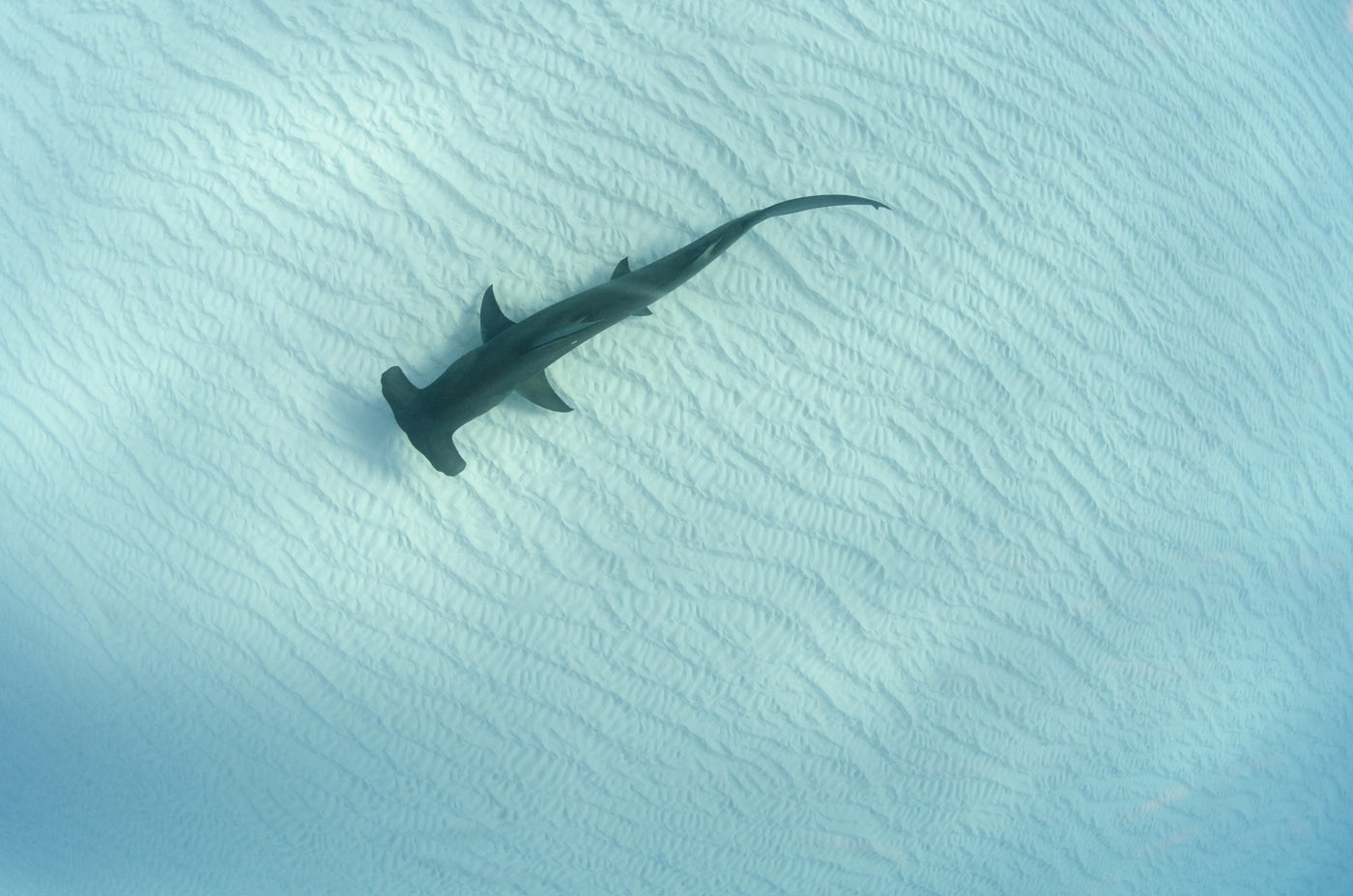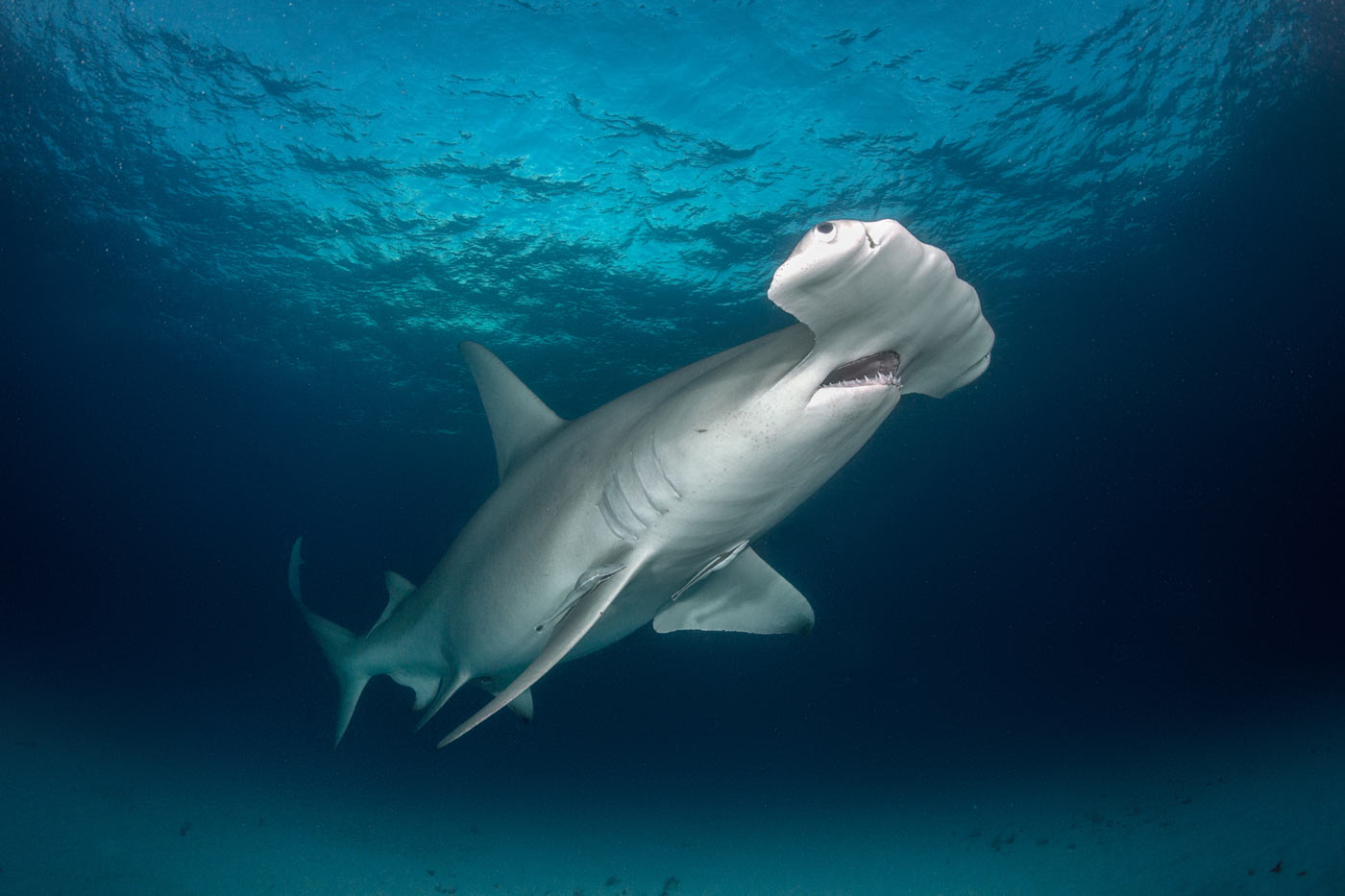The little scalloped hammerhead shark is out cold, impervious to the rubber tube that’s being passed into its tiny nasal cavity and wiggled into position next to a set of electrical sensors.
“It’s called an EOG, an electro-olfactogram,” says Steve Kajiura, the scientist who’s doing the wiggling. “This gives us an indication of how sensitive the hammerheads are to smell.”
Once the tube is in place, he’ll pass amino acids — odors — through it, which will cause a murmur of a charge when the shark’s nose unconsciously takes a whiff. That charge will first register on the sensors, then on a nearby computer, where it will appear as a chicken-scratch pattern.
“We’re going to do the same thing to sandbar sharks and see how they compare,” he says.
Kajiura, one of the leading researchers on hammerhead physiology and an assistant professor of biology at Florida Atlantic University, borrowed the University of Hawaii’s Institute of Marine Biology’s Shark Research Center in Kaneohe Bay, Oahu, Hawaii, to explore exactly what goes on inside that head.
“Anytime someone sees a hammerhead shark, one of the first questions they’re going to ask is, why do they have such a funny-looking head,” Kajiura says. “There’s this basic, fundamental question — nothing else looks like that, there’s no other fish that has that weird-looking head. Why would we see this in the hammerhead shark?”
He’s poking at the answer to that question one drop at a time, comparing the anatomy of sharks’ heads, their senses, and how they use those senses to hunt, in a grand attempt to explain one of nature’s most bizarre adaptations. So far, though, his research hasn’t provided any real “eureka!” answers. Instead, he’s mostly uncovered surprises and more head-scratching questions, but in the meantime, he’s got a front-row seat to whatever evolutionary process made such a head happen.
“Because there are several hammerheads with several different-shaped hammers, they provide a great model for us to look at the evolution of this strange shape and answer some very interesting evolutionary questions,” Kajiura says. “What is the significance of this head? Why did it evolve in the first place, what’s it good for, and what can we gather about how these sharks have evolved based on this unusual head shape?”

Getty Images
Shark Science
There are nine species of hammerheads that occur around the world, from the 18-foot great hammerhead (Sphyrna mokarran) to the four-foot bonnethead (Sphyrna tiburo). They’re primarily a tropical and subtropical fish, and as adults, they’re most often found in the open ocean around seamounts, although some of the smaller species hunker closer to shore in bays and estuaries. Like other sharks in the neighborhood, hammerheads eat crabs, squid, shrimp, and fish. Larger ones will eat stingrays and even smaller sharks. At first glance, they’re just like all the other sharks.
They just look, well, there’s that head.
Unlike conventionally shaped sharks — let’s call them “pointy heads” — hammerhead heads are flattened and elongated — “Dorso-ventrally compressed and laterally expanded,” as Kajiura would say. Their eyes and nostrils are on each end of that head, which looks enough like an airplane wing, or airfoil, to make some shark experts wonder if the cephalofoil isn’t some kind of shuck-and-jive agility-enhancing modification.

Getty Images
But we’re getting ahead of ourselves.
According to geneticists, the hammerheads probably built their addition to the family tree house suddenly, about 20 million to 25 million years ago. DNA research done in the 1990s suggests the head probably appeared out of the deep blue in something similar to the winghead shark (Eusphyra blochii), which has a cephalofoil of about 40 percent to 50 percent of its overall length. Since then, it’s slowly changed shape as each species has evolved to suit its habitat. The little bonnethead is probably one of the newest adaptations, with a head only about 20 percent of its length. According to physiologists like Kajiura, that’s backward — the head should get bigger, not smaller, as adaptation causes the sharks’ body to add a spare room onto the house as its habitat requires.
While Kajiura is not weighing in until more studies are done, the sharks’ incredible shrinking head may mean the cephalofoil isn’t some great “invention” of biology. In fact, if it’s going the other way, it might be something of a hindrance.
As we were saying, for the longest time, no one’s been really sure of why the sharks’ heads look like it does and why that particular shape would be advantageous to a hungry fish. Sure, there are theories, but studies that explore how the shark uses that head have been few and far between, until relatively recently.
“What’s amazing is that there’s so much information out there, so many ideas out there, that have never been tested,” Kajiura says. “A lot of people have put forth different ideas over the years, but no one’s gone out and actually tested them by comparing a hammerhead to a carcharhinid (family of sharks that have more standard-looking snouts) shark.”
There are essentially two schools of thought. The first hypothesis, the most widely accepted one, suggests the head is a giant sensor to detect food, like an oversized metal detector scanning the beach for rings, watches, and loose change. All sharks — all elasmobranches, really, including skates and rays — have thousands of pores on their heads that detect electrical “energy” from other aquatic animals. These pores connect through canals full of electrically conductive jelly to tiny sacks in the fish’s head, altogether creating an organ called the ampullae of Lorenzini. If you spread out the distribution of the ampullae by making the fish’s head wider, you allow it to scan more area for food with the same effort. This is the same logic that favors the 42-inch riding lawnmower over the 21-inch push mower. Nature rewards this kind of efficiency.
The other explains the cephalofoil shape as a wing that creates lift to increase the shark’s maneuvering abilities. The idea is that in the open ocean, the cephalofoil would generate more force on the turning end — and the eating end — to let the shark whip around after prey.
Kajiura has tested both ideas by comparing young scalloped hammerheads (Sphyrna lewini), bonnetheads, and pointy-headed sandbar sharks (Carcharhinus plumbeus). Surprisingly, he’s found hammerhead sharks have nearly identical physiologies as carcharhinic sharks, which really makes you wonder.
Kajiura’s first order of business was testing the scanner theory. He studied the heads of the three species of sharks to determine how the electroreceptive pores were distributed over their heads. When he corrected for adult body size — the three species are different sizes when they’re fully mature — he found out that each shark has the same density of pores, but the hammerheads and carcharhinic sharks had the pores in different places.
On the hammerheads’ cephalofoil, the pores mostly cover the front of the wing and the underside. On the carcharhinic sharks, they’re spaced more or less evenly around the head. That’s almost certainly because of how each fish hunts, Kajiura says. At least as juveniles, hammerheads primarily eat buried food, while sandbar sharks eat fish, which may be beside, above, or behind them. A pointed head with sensors on its sides, top, and bottom would allow carcharhinic sharks to sense those “three-dimensional” fish more effectively.
Then he tested the three species of sharks in a tank with a series of electric poles mounted on its floor to see if hammerheads were any more sensitive than carcharhinic sharks to the electrical energy of prey. He measured how far away from the poles the sharks “locked on” to the electrical current to determine how much voltage the sharks respond to. Both types of sharks were able to pick up on small charges — about 10-billionths of a volt — and there was no difference between the sensitivity of the two. The only difference was that the hammerhead found the pole faster once it detected the signal, again, because it mowed a wider swath with the bigger head.
“You can take two sharks, a hammerhead and a sandbar that are the same size, about 60 cm long, and they will both swim at the same velocity,” Kajiura says. “In a day — 24 hours of just cruising — a sandbar shark’s head will cover the equivalent of half a football field of area. In that same time, the same-sized hammerhead would cover the equivalent of one and a third football fields. If the hammerheads are sampling a lot more ground in the same amount of time than the sandbar sharks, clearly they’re going to have a lot more probability of finding prey items buried in the sand. That’s a big advantage.”
Next, he had to find out if the fish use their heads as wings. He used a video camera mounted over an outdoor aquarium at the Shark Lab to record how the animals turned. If a hammerhead uses its head as a true “hydrofoil,” the theory goes, it would bank its head as it turned. There would also be some twist in the sharks body, and the inside pectoral fin would roll underneath, like the wing of a turning airplane.
“That’s almost a common idea,” he says. “We were quite surprised when we found out they didn’t.”
While the video showed that young hammerheads were more flexible than the sandbar sharks, made sharper turns, and barely slowed down through turns, they stayed relatively flat while sandbar sharks tended to roll their entire bodies — just the opposite of what Kajiura was expecting. In afterthought, though, it’s a forehead-slapper now. The flat turn is the result of exactly the kind of lift they expected the cephalofoil to produce. Except they were thinking about the wrong kind of wing. Instead of an airplane wing, the shark’s head resembles a race-car wing, which helps the car stick to the track as it turns and accelerates — the same low-to-the-ground agility the shark needs when it hunts.
“Clearly, it provides some advantage,” Kajiura says. “But at the same time, you’d think there’s got to be a con for having that big of a head.”

Getty Images
Small Bites
Indeed, there is. Kajiura has just begun to explore the sharks’ vision. With eyes on the far ends of their head, hammerheads have a gigantic blind spot right in front of their face that they don’t seem to be able to compensate for. Even ideas that they saw their heads back and forth, looking out one eye, then the other, don’t seem to hold up in research experiments. Drop a fish on the head of a hammerhead shark, Kajiura says, and you really frustrate it, while a pointy-headed shark will just roll over and nab the morsel with the corner of its mouth.
After running the hammerheads and sandbar sharks through the sniff tests on the lab table, Kajiura will compare the EOGs for the two species, to determine which, if either, has the more acute sense of smell. Already, he knows hammerheads don’t have any more surface area to smell with than carcharhinic sharks, but he might discover they’ve got more sensors packed into the tissue. He faces the possibility, though, that they don’t. Just like with the electroreceptors in their skin, sharks may just use what they’ve got differently. Spreading the fish’s nose apart, the cephalofoil may allow the fish to triangulate the location of prey, which could make hunting more efficient. And once again, Kajiura’s got more questions to answer, and still no really good “why” to explain that head.
“I don’t think we can definitely say the head evolved for this purpose: blank,” he says. “There are too many factors that come into play, and you can’t necessarily tease one apart from another. These things evolved in concert.”
And in the meantime, he’ll keep trying. The answer might be out there somewhere. Someone will just have to wiggle it loose.






